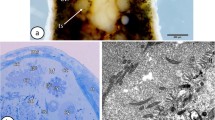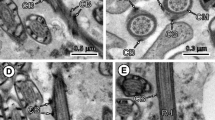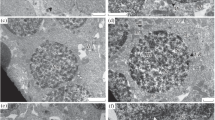Abstract
Spermatophore development and ultrastructure of the mature sperm ofCraterostigmus tasmanianus were studied using light and electron microscopy. InC. tasmanianus, as in the Scolopendromorpha, the spermatophore develops within the vas deferens. The latter consists of three parts, each with a different morphology. The first may be involved in guiding the sperm to roll up into typical ring-like structures, while the other two, which show an evident secretory activity, secrete the acellular wall of the spermatophores. The ultrastructure of mature spermatozoa showed that a very close similarity exists between Craterostigmomorpha and Lithobiomorpha, especially regarding the organization of the connecting piece. Based on this similarity, we consider the Craterostigmomorpha together with the Scolopendromorpha, Geophilomorpha and Lithobiomorpha (=Pleurostigmorphora) to be the sister group of the Scutigeromorpha.
Similar content being viewed by others
References
Beniouri R, Descamps M (1985) Etude ultrastructurale du spermatozoide deCryptops hortensis Leach (Myriapode Chilopode). Arch Biol (Bruxelles) 96:195–207
Borucki H (1996) Evolution und Phylogenetisches System der Chilopoda (Mandibulata, Tracheata). Verh Naturwiss Ver Hamburg (NF) 35, pp 95–226
Brunhuber BS (1970) The formation of the scolopendromorph spermatophore. Bull Mus Nat Hist Natur 41 suppl 2:24–28
Camatini M, Saita A, Cotelli F (1974) Spermiogenesis inLithobius forficatus (L.) at ultrastructural level. In: Lower JB (ed) Symposia of Zoological Society of London, 32. Myriapoda. Academic Press London, New York, pp 231–235
Demange JM (1945) Le spermatophore de quelques Scolopendromorphes (Myriapodes-Chilopodes). Bulletin Muséum, 2o série, T. XVII no6
Demange JM (1988) Arthropoda-Chilopoda. In: Adiyodi KG, Adiyodi RG (eds) Reproductive biology of invertebrates, vol 3. John Wiley and Sons, New York, 473–485
Demange JM, Richard J (1969) Morphologie de l’appareil génital mâle des scolopendromorphes et son importance en systematique (Myriapode, Chilopodes). Bull Nat Mus Hist Natur (Paris) 40:968–983
Descamps M (1972) Étude ultrastructurale du spermatozoïde deLithobius forficatus L. (Myriapode Chilopode). Z. Zellforsch. 126:193–205
Dohle W (1980) Sind die Myriapoden eine monophyletische Gruppe? Eine Diskussion der Verwandtschaftsbeziehungen der Antennaten. Abh Naturwiss Ver Hamburg NF 23:4–104
Dohle W (1985) Phylogenetic pathways in the Chilopoda. Bijdr Dierk 55 (1):55–66
Dohle W (1990) Some observations on morphology and affinities ofCraterostigmus tasmanianus (Chilopoda). In: Minelli A (ed) Proceedings of the 7th International Congress of Myriapodology, E.J. Brill, Leiden, pp 68–79
Fabre L (1855) Recherches sur l’anatomie des organes reproducteurs et sur le développement des Myriapodes. Ann Sci Nat Ser Zool 3:257–316
Franchi E, Camatini M, Cotelli F (1978) Comparative analysis of mature spermatozoa in Chilopoda (Arthropoda, Myriapoda) J Submicrosc Cytol 10:112–113
Horstmann E (1968) Die Spermatozoen vonGeophilus linearis Koch (Chilopoda). Z Zellforsch 89:410–429
Jamieson BGM (1987) The ultrastructure and phylogeny of insect spermatozoa. Cambridge University Press, Cambridge
Jangi BS (1956) The reproductive system in the male of the centipede,Scolopendra morsitans Linn. Proc Zool Soc (London) 127:145–159
Karnovsky MJ (1965) A formaldehyde-glutaraldehyde fixative of high osmolality for use in electron microscopy. J Cell Biol 27:137A-138A
Klingel H (1960) Vergleichende Verhaltungsphysiologie der ChilopodenScutigera coleoptrata L. (“Spinnenassel”) undScolopendra cingulata Latr. (Skolopender). Z Tierpsychol 17:11–30
Lewis JGE (1981) The biology of centipedes. Cambridge Univ Press, Cambridge
Mazzini M, Carcupino M, Fausto AM, Puri C, Zapparoli M (1991) Comparative sperm structure in Chilopoda. In: Baccetti B (ed) Comparative spermatology 20 years after. Raven Press, New York, pp 990–995
Mazzini M, Carcupino M, Fausto AM, Puri C, Zapparoli M (1991) Further observations on the ultrastructure of mature sperm ofScutigera coleoptrata (L.) (Chilopoda-Scutigeromorpha). J Submicrosc Cytol Pathol 24 (2):251–256
Mazzini M, Fausto AM, Puri C, Zapparoli M, Carcupino M (1993) End-piece formation during spermiogenesis of Scolopendromorpha (Chilopoda). J Submicrose Cytol Pathol 25 (2):257–262
Prunescu C (1965) Le système gétital et trachéal deCraterostigmus (Craterostigmomorpha, Chilopoda). Rev Roum Biol Ser Zool 10:309–314
Prunescu C, Shinohara K, Mesibov R (1993) The genital system inEsastigmatobius longitarsis andCraterostigmus tasmanianus: phyletic relationships in some chilopods. 9th International Congress of Myriapodology, Paris
Shear WA, Bonamo PM (1988) Devonobiomorpha, a new order of Centipedes (Chilopoda) from the Middle Devonian of Gilboa, New York State, USA, and the phylogeny of centipede orders. Am Mus Novit 2927:1–30
Author information
Authors and Affiliations
Corresponding author
Rights and permissions
About this article
Cite this article
Carcupino, M., Fausto, A.M., Bernardino Ortega, M.L. et al. Spermatophore development and sperm ultrastructure inCraterostigmus tasmanianus (Chilopoda, Craterostigmomorpha). Zoomorphology 116, 103–110 (1996). https://doi.org/10.1007/BF02526942
Accepted:
Issue Date:
DOI: https://doi.org/10.1007/BF02526942




